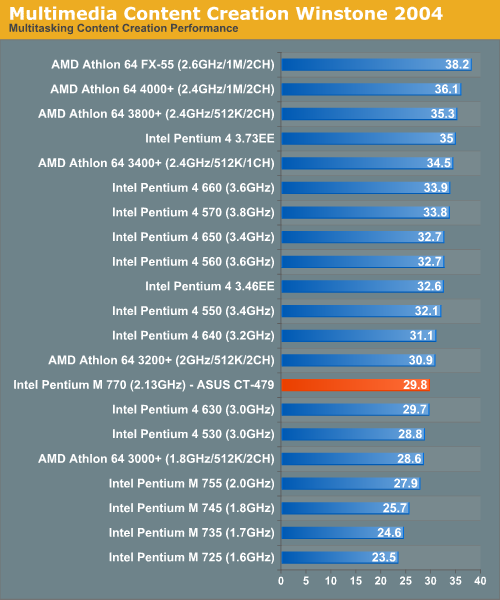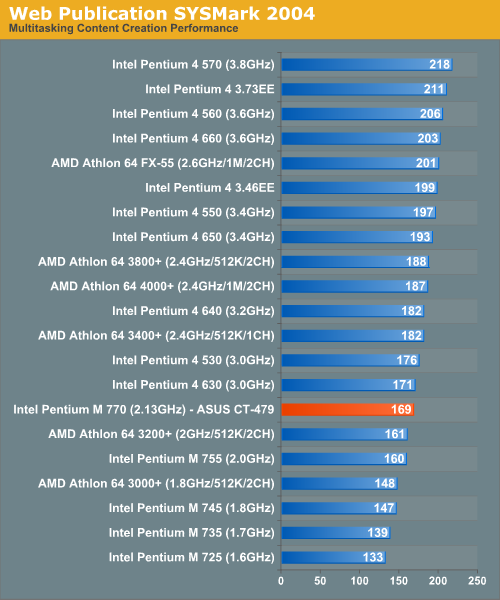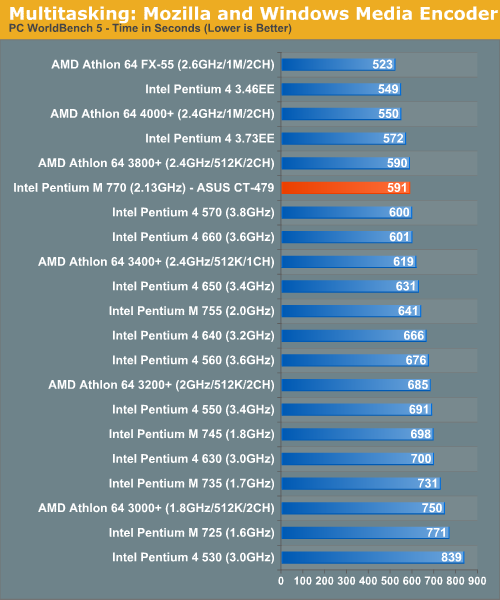Intel's Pentium M Desktop Part II: ASUS' Pentium M to Pentium 4 Socket Adapter
by Anand Lal Shimpi on March 24, 2005 1:31 PM EST- Posted in
- CPUs
Multitasking Content Creation
MCC Winstone 2004
Multimedia Content Creation Winstone 2004 tests the following applications in various usage scenarios:- Adobe® Photoshop® 7.0.1
- Adobe® Premiere® 6.50
- Macromedia® Director MX 9.0
- Macromedia® Dreamweaver MX 6.1
- Microsoft® Windows MediaTM Encoder 9 Version 9.00.00.2980
- NewTek's LightWave® 3D 7.5b
- SteinbergTM WaveLabTM 4.0f

ICC SYSMark 2004
The first category that we will deal with is 3D Content Creation. The tests that make up this benchmark are described below:"The user renders a 3D model to a bitmap using 3ds max 5.1, while preparing web pages in Dreamweaver MX. Then the user renders a 3D animation in a vector graphics format."

Next, we have 2D Content Creation performance:
"The user uses Premiere 6.5 to create a movie from several raw input movie cuts and sound cuts and starts exporting it. While waiting on this operation, the user imports the rendered image into Photoshop 7.01, modifies it and saves the results. Once the movie is assembled, the user edits it and creates special effects using After Effects 5.5."

The Internet Content Creation suite is rounded up with a Web Publishing performance test:
"The user extracts content from an archive using WinZip 8.1. Meanwhile, he uses Flash MX to open the exported 3D vector graphics file. He modifies it by including other pictures and optimizes it for faster animation. The final movie with the special effects is then compressed using Windows Media Encoder 9 series in a format that can be broadcast over broadband Internet. The web site is given the final touches in Dreamweaver MX and the system is scanned by VirusScan 7.0."

Mozilla + Media Encoder











48 Comments
View All Comments
ElFenix - Sunday, March 27, 2005 - link
i'm confused, were all the benches done at 5:4 memory ratio? how is the performance at 1:1? if the added bandwidth from running 5:4 can't be used, isn't it better to run synchronus?joe360 - Saturday, March 26, 2005 - link
I have a socket-478 P4 2.8 Presscott in a laptop, is there a way I can get the Dotan in there instead?Hardtarget - Friday, March 25, 2005 - link
Wow thanks for the update Anand. I just read both of these articles and was extremely impressed with them.Real good work, I can't wait for the Yonah just to see what happens!
drewski - Friday, March 25, 2005 - link
i agree w/ posts 9, 18, & 28 regarding the changing of multiple variables making some of the comparisons between architecture's a bit of a guess.thanks for your post, Anand. it helps clarify things, though having the benches would help. maybe you can cut and paste it into the article! ;-)
still, i think this was less of an oversight than that terrible article on the OCZ Vx memory by Wesley. has that ever been corrected?
Anand Lal Shimpi - Friday, March 25, 2005 - link
For those wondering about the 865 vs 855 comparison, one thing I tried to stress in the article (especially during the benchmark comments) is that in many cases the performance improvement was barely anything, thus meaning that the magic solution to the Pentium M's desktop viability was far from just add more memory bandwidth. The reason that point is important is because after the first article, many assumed that more memory bandwidth and a faster FSB would make the Pentium M infinitely more competitive. But look at media encoding and the majority of the MCC tests and those two improvements didn't change things all that much.The Pentium M 770 has a 6.65% increase in core clock speed over the Pentium M 755, in any benchmark where the 770 offers a greater than 6.65% increase in performance you know that performance improvement is due to more than just the clock speed, mainly the faster FSB and the correspondingly higher memory bandwidth. Since the 855GME is already memory bandwidth limited with a 400MHz FSB, increasing the bus frequency to 533MHz won't do anything for performance on that chipset, so that's why you can attribute the performance gains that do exist to the 865 platform as a whole. Also keep in mind that most applications rarely scale at a 1:1 ratio with CPU clock speed; even some of the more CPU limited applications will scale at a 50% rate with clock speed - so really what you're looking for are any performance improvements greater than about 3%, those are due to the 865 platform.
There are a few areas where the added memory bandwidth does make a huge difference - mostly in the workstation level SPEC tests.
So although we didn't run direct comparison numbers between the 855GME and the 865, there is enough information in this article to (as many of you have already concluded) find out that for the most part, the added memory bandwidth does very little (on the order of a few percent). The real benefit of the ASUS solution is that you get a much more mature motherboard, more stable, and a lot cheaper. I apologize if I didn't properly stress this information throughout the article and in the conclusion.
Take care,
Anand
PrinceGaz - Friday, March 25, 2005 - link
#31- the P-M 770 has a 533MHz FSB. That's how fast data moves to and from the northbridge memory-controller. The CPU doesn't care about whether the chipset memory-controller is single or dual-channel. Using dual-channel DDR333 provides 667MHz of memory bandwidth for the northbridge, of which the P-M 770 will utilise a maximum of 533MHz (when not overclocked), so it is taking advantage of dual-channel.Unfortunately, as others have pointed out, the article was very poor because there was no comparison of the same P-M on the i855 (single channel) and i865 with adapter (dual channel) chipsets. The purpose of the article was to see what effect the adapter and i865 had on performance. Of course the P-M 770 on the i865 was faster than the P-M 755 on the i855, because the P-M 770 has a higher core speed. What you did was like comparing a S754 3000+ (2GHz) and a S939 3500+ (2.2GHz), and concluding that S939 provides a good performance boost over S754 because it is dual-channel, whilst overlooking the clock-speed difference which has a much greater impact.
classy - Friday, March 25, 2005 - link
I don't even see this even as a viable solution. It is a real dog in many instances and the biggest problem is you have to overclock it. Now for many of us that is not a problem, until you factor in that your talking about a rather extreme overclock, even for an Intel Processor. If you can't reach these speeeds with a low priced one, only a fool would buy one. Especially now since I can go over to Zip and buy a retail AMD 64 4000+ for $550 dollars. And don't forget AMD 64 chips overclock fairly well too. If this was 2 years ago it would be viable or even if was say the priced like an XP or 64 3000+ chip you might consider it. But given the necessiity that it has to be overclocked to get good performance, high price, and extremely limited platform support I see no reason whatsoever to buy a Pentium M. And I am running an Intel setup as I type this. They have just fallen behind and it doesn't look like they are going to catch up any time soon either.fitten - Friday, March 25, 2005 - link
Something to remember about the PentiumM, while the chipset it sits on may be dual channel memory, the PentiumM itself, is not. It's much like the Athlon XPs and the nForce2 chipset (CPU is single channel, chipset is dual channel). So, you really aren't comparing a "real" dual channel processor like the S939 and S940 Athlon64/Opterons. The PentiumM can only pull data in one channel width per read, regardless of the chipset it sits on. The S939/S940s can pull in two channel widths per read.That being said, there definitely seems to be some improvement in going to the hybrid dual channel boards.
Quanticles - Friday, March 25, 2005 - link
What about HL2 preformance when it's not overclocked?xsilver - Friday, March 25, 2005 - link
Where this cpu would really work is in a xpc system where extreme performance isnt really nessessary... but think of running the whole pc on only the 1 PSU fan